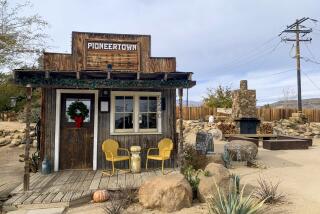Pair Enrich Their Tiny Hometown
- Share via
OSGOOD, Ind. — This is a story about a love triangle.
There was Goldie. There was Gilmore. And there was Osgood.
Gilmore and Golda (friends called her Goldie) Reynolds were husband and wife for 62 years. They loved each other. They loved to play the stock market.
And they loved Osgood. All 2 1/2 square miles of it.
Not that they bragged about it. They were private people. They lived in a simple stucco home. They didn’t wear fancy clothes or flashy jewels. They were tight-lipped about their good fortune and their good deeds. Most people didn’t know they contributed to the volunteer fire department or that Goldie helped pay for the new town hall.
Even after they died--Gilmore in 1990, Goldie in 1998--they still had a secret.
Now everyone in town knows it. Goldie and Gilmore Reynolds left Osgood and its 1,688 residents virtually their entire estate, totaling $23 million.
More than $650,000 already has been handed out, and the latest grants were announced last week. Projects range from new park benches and water line repairs to sprucing up the livestock building used during the Ripley County fair.
Not exactly a lottery winner’s fantasy, but Goldie and Gilmore were practical at heart, and their gift already is doing what they set out to do:
Making this town a better place to live.
Like so many one-stoplight towns along the back roads of middle America, Osgood desperately needs a face lift.
“Nothing has been done here in 30 years,” says Jeff Volz, chairman of the three-member town board. “This money will get a lot of things done. We’re way behind.”
The disrepair isn’t obvious. Osgood, 42 miles west of Cincinnati, is a typical Midwestern small town, from the lonely trill of the railroad whistle to the lace curtains on the cafe window and the Masonic lodge and Fish and Chirps pet store on the main street.
But the sewer lines are leaking. The water lines are rusty. Many streets don’t have sidewalks.
The tax rate is high, the employment base low.
And though $23 million might not make a Wall Street wizard’s heart flutter, it is more than enough to get the adrenaline pumping in Osgood. Consider:
The money exceeds the assessed valuation of the entire town. And, just for comparison’s sake, it’s more than 25 times the fixed annual budget.
“Now we have a chance to do something instead of just dreaming about it,” says Gary Norman, the town’s treasurer-clerk.
So who were the do-gooders of Osgood?
Though Goldie and Gilmore Reynolds outlived most of their peers (both died in their 90s), one memory lingers: the two of them, silhouetted in their side window at night, reading the Wall Street Journal.
“From daylight to dusk, they’d be studying stocks and they loved every minute of it,” says Neil Comer, one of the five managers of the Gilmore & Golda Reynolds Foundation. “Goldie would tell me that with a gleam in her eye. That was the thing she and Gilmore enjoyed doing together.”
They had no children, but Comer says “they thought of these stocks almost like their offspring. They would watch over them, see how they were growing. It was a little strange--but then maybe not.”
Goldie was a worrier. The one-time schoolteacher, who put her foot down on Gilmore’s daredevil ways, also had an accountant’s eye for detail, charting the progress of their stocks daily on graph paper, calculating percentages of their investments to the penny.
“Goldie was the bean counter,” recalls Gene Courtaney, whose wife was her niece.
“She made sure all the bills were paid on time. Gilmore would think about what they would be doing five, 10, 15 years from now.”
Gilmore was a partner in a Chevy dealership in the 1920s when he spotted Golda Black, a twentysomething schoolteacher. He invited her to drive to Milan--11 miles away--to pick up a new car off the train.
Love blossomed. They married in 1928 and settled in Gilmore’s childhood home on Buckeye Street.
Courtaney remembers Gilmore’s business philosophy: “You want to keep good employees? Pay them $50 more than the going rate.”
In 1964, the couple sold their business to Phillips Petroleum Co. and they retired. Their only public project was a scholarship fund at the local school.
Comer says he never asked Goldie why the couple bestowed their fortune on Osgood.
“It was almost a foregone conclusion,” he says. “They lived here all their lives. They never left. They loved this town.”
When Gilmore died at age 91, many of Goldie’s interests did, too. She stopped going to their winter home in Florida. She wouldn’t even eat at the breakfast nook she had shared with her husband, standing instead at the kitchen counter, looking out the window.
But she remained faithful to Osgood. The checks would come in, sometimes out of the blue--$10,000 to the fire department, $100,000 for the town hall. The only strings attached were invisible: no publicity, no mention of the donor.
So far there is no plaque or statue in the park in their honor.
Goldie’s great-nephew, Lemen, thinks he knows what she’d say to any such idea:
“Why would you waste money on that?”
More to Read
Inside the business of entertainment
The Wide Shot brings you news, analysis and insights on everything from streaming wars to production — and what it all means for the future.
You may occasionally receive promotional content from the Los Angeles Times.








